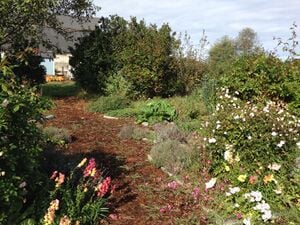
Gardening is the practice of tending a garden. Gardening is often a domestic activity and is often done by the people who also directly benefit from it (unless they employ a gardener). By contrast, agriculture and horticulture focus on commercial value.
A network of crops grown near the house helps to further ensure regional food security and encourages self-sufficiency and cooperative interdependence within communities.[1] With every bite of food raised from urban gardens, negative environmental impacts are reduced in numerous ways. For instance, vegetables and fruits raised within small-scale gardens and farms are not grown with tremendous applications of nitrogen fertilizerW required for industrial agricultural operations. The nitrogen fertilizers cause toxic chemical leaching and runoff that enters our water tables. Nitrogen fertilizer also produces nitrous oxide, a more damaging greenhouse gas than carbon dioxideW.
Local, community-grown food also requires no imported, long-distance transport which further depletes our fossil fuel reserves.[2] In developing more efficiency per land acre, urban gardens can be started in a wide variety of areas: in vacant lots, public parks, private yards, church and school yards, on roof tops (roof-top gardensW), and many other places. Communities can work together in changing zoning limitations in order for public and private gardens to be permissible.[3] Aesthetically pleasing edible landscaping plants can also be incorporated into city landscaping such as blueberry bushes, grapevines trained on an arbor, pecan trees, etc.
With as small a scale as home or community farming, sustainable and organic farming methods can easily be utilized. Such sustainable, organic farming techniques include: composting, biological pest controlW, crop rotationW, mulching, drip irrigation, nutrient cyclingW and permaculture.[4] For more information on sustainable farming systems, see sustainable agriculture.
See also[edit | edit source]
- To browse Appropedia's information on gardening, view the "horticulture and gardening" category.
- The agriculture category will be useful for specific crops and techniques.
References[edit | edit source]
- ↑ Flores, H.C. Food Not Lawns: How to Turn Your Yard into a Garden and Your Neighborhood into a Community. New York: Chelsea Green, 2006.
- ↑ Nyerges, Christopher. Urban Wilderness: a guidebook to resourceful city living. Culver, CA: Peace Press, 1979.
- ↑ Hemenway, Toby. Gaia's Garden. New York: Chelsea Green, 2000.
- ↑ Warde, Jon, ed. The Backyard Builder: Over 150 Projects for Your Garden, Home and Yard. New York: Random House, 1994.